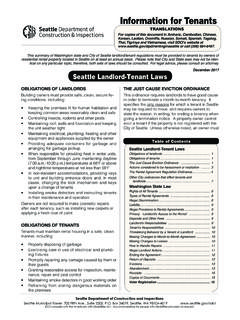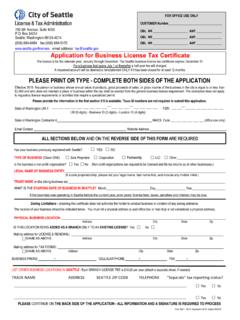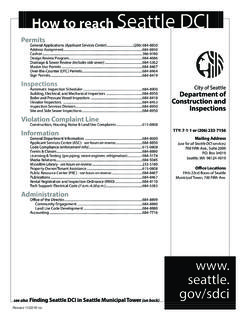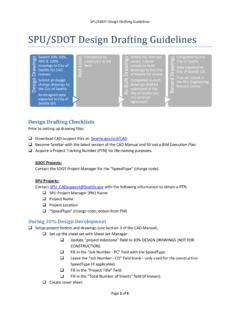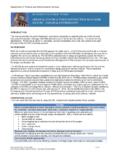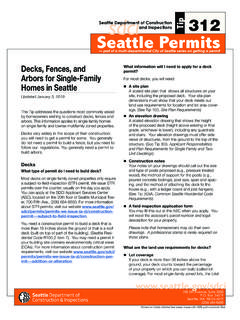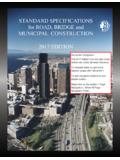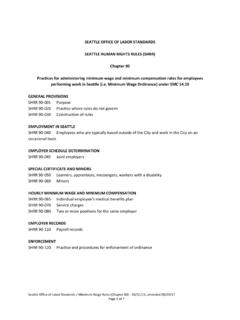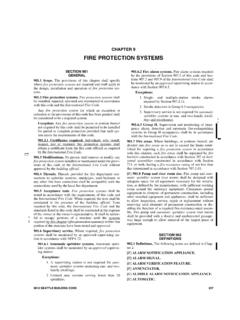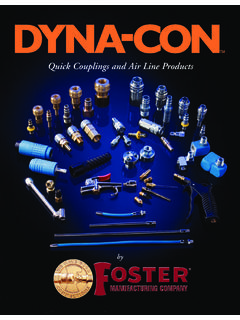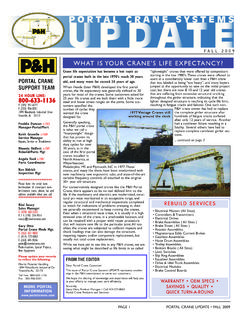Transcription of 0056.35 Personal Protective Grounding of …
1 seattle City Light WORK PRACTICE Standard Number: Superseding: Effective Date: Page: New April 10, 2015 1 of 17 Standards Coordinator John Shipek Standards Supervisor John Shipek Unit Director Darnell Cola Personal Protective Grounding of overhead distribution Lines 1. Table of Contents 2. Scope .. 2 3. 2 4. Definitions .. 2 5. Introduction .. 3 6. General Procedures .. 3 General .. 3 Equipotential Zone .. 4 Protective Grounding Equipment .. 4 Testing .. 4 Order of Connection .. 4 Order of Removal .. 4 Additional Precautions .. 4 Removal of Grounds for Test .. 4 Conductor Separation .. 4 Ground Personnel .. 5 Covered overhead Primary .. 5 Exceptions .. 5 7. Tools and Equipment .. 5 8. Detailed Procedures .. 8 distribution Lines with Common Neutral .. 8 distribution Lines with Primary Neutral .. 10 Grounds Installed One Span Away from the Worksite.
2 12 Grounds Installed More Than One Span Away from the Worksite .. 14 Grounds for Broken Primary Conductors on the Ground .. 16 9. References .. 17 10. Sources .. 17 seattle City Light WORK PRACTICE Personal Protective Grounding of overhead distribution Lines Standard Number: Superseding: Effective Date: Page: New April 10, 2015 2 of 17 2. Scope This work practice covers the use of Personal Protective grounds on seattle City Light s (SCL s) 4, 13, , and kV, overhead distribution systems. The following topics are outside the scope of this work practice: Grounding theory Switching and clearance procedures Worker training and certification requirements Grounding equipment and tool purchasing specifications Grounding equipment and tool maintenance procedures Traveling grounds Voltage detector operation Provisions covered under WAC 296-45-325 Protection of workers outside the established equipotential zone Mitigating hazards associated with electric field and electromagnetic field induction kV delta system at Cedar Falls 3.
3 Application This work practice is directed at qualified persons who are tasked with applying Personal Protective grounds on SCL s 4, 13, , or kV, overhead distribution system. The objective of this work practice is to make the workplace as free from recognized hazards as reasonably possible. Following these rules may sometimes require that employee safety receive a higher priority than speed and work performance. 4. Definitions Cluster bar A terminal that is temporarily attached to a structure that provides a means for the attachment and bonding of Grounding and bonding cables to the structure. Typically used with Grounding jumpers to establish an equipotential zone. Syn: cluster support, pole chain binder. Electric field induction - The process of generating voltages or currents to ground or both in a conductive object or electric circuit by means of time-varying electric fields. Syn: capacitive coupling. Electromagnetic field induction - The induction process that includes both electric and magnetic fields and generates a circulating current between two grounded ends of a line due to the proximity of an adjacent or close energized and loaded line.
4 Syn: electromagnetic coupling. Equipotential - An identical state of electrical potential for two or more items. Also, for the purposes of Protective Grounding , a near identical state of electrical potential. Syn: equal potential. Equipotential zone - Created by applying Personal Protective grounds, which provide a work space where all material and hardware within the worker s reach is energized at the same potential if the lines accidentally become energized. Syn: equal potential zone (EPZ). Grounding jumper - A system of ground clamps and covered cables suitable for carrying fault current. Syn: ground set, ground. Personal Protective ground - A cluster bar installed on the pole below the work position, and a Grounding jumper installed between the neutral and the cluster bar. The objective of Personal Protective grounds is to create an equipotential zone. seattle City Light WORK PRACTICE Personal Protective Grounding of overhead distribution Lines Standard Number: Superseding: Effective Date: Page: New April 10, 2015 3 of 17 Personal Protective Grounding - Combines working grounds and Personal Protective grounds in a way that reduces the potential voltage difference at the worksite (voltage across the worker) to a safe level.
5 Syn: worksite Grounding , single-point Grounding , equipotential Grounding , equal potential Grounding . Qualified person - A person who is familiar with the construction of, or operation of such lines and/or equipment that concerns his/her position and who is fully aware of the hazards connected therewith, or, one who has passed a journey status examination for the particular branch of the electrical trades with which he/she may be connected. Refer to WAC 296-45-035 for the complete, legal definition. Working grounds - Grounding jumpers installed between the phase conductors and system neutral conductor, at or near the worksite. The objective of working grounds is to ensure the circuit opens in the fastest available clearing time. If the system is three-phase, the Grounding method must short circuit all three phases. Syn: grounds. 5. Introduction Voltage may appear at a worksite due to accidental energization either through the isolating device or due to contact with another energized circuit.
6 Voltages or currents may be present due to electric or magnetic induction from adjacent energized circuits or due to a direct or indirect lightning stroke. When a hazard exists that is not covered by this work practice, the lead worker and employees are expected, in good faith, to mutually discuss the hazard and agree how to perform the work with the greatest degree of safety. Experience has proven that the majority of injuries and deaths are preventable. Most injuries and deaths are not due to defective equipment but are due to failure on the part of the employees and those in authority to observe safety rules and failure to use safety devices. This work practice is a compilation of experience and common sense. In general, the safest way to ground distribution lines and equipment is to create an equipotential zone by using Personal Protective grounds (a combination of working grounds and Personal grounds). This limits the voltage across and the current that flows through the worker to minimum levels.
7 Workers are best protected when Personal Protective grounds are installed at the worksite. However, there will be situations where this is impractical or impossible. In these situations, Personal Protective grounds shall be installed as close to the worksite as possible. Workers on the ground may be exposed to higher step and touch potential when Personal Protective grounds are used. While work is in progress, ground personnel can protect themselves by staying away from the pole or temporary ground rod, where step and touch potential are higher. Personal Protective grounds also are intended to protect the worker from induced voltages created by parallel lines or static charge. This Grounding method also insures the quickest operation of Protective devices (relays and circuit breakers or fuses). 6. General Procedures General To work on exposed energized live parts, or near enough to them to expose any employee to any hazard they present, the provisions of WAC 296-45-325 shall apply.
8 To work lines or equipment as de-energized, the lines or equipment shall be de-energized under the provisions of WAC 296-45-335 and grounded as specified in this work practice. For specific exceptions to this rule, refer to Section of this document. seattle City Light WORK PRACTICE Personal Protective Grounding of overhead distribution Lines Standard Number: Superseding: Effective Date: Page: New April 10, 2015 4 of 17 Equipotential Zone Temporary Protective grounds shall be placed at such locations and arranged in such a manner as to prevent each employee from being exposed to hazardous differences in electrical potential. Protective Grounding Equipment Protective Grounding equipment shall be capable of conducting the maximum fault current that could flow at the point of Grounding for the time necessary to clear the fault. Grounding jumpers shall have approved ferrules and Grounding clamps that provide mechanical support for jumper cables independent of the electrical connection.
9 Protective grounds shall have an impedance low enough to cause immediate operation of Protective devices in case of accidental energizing of the lines or equipment. CAUTION! In no case shall a Grounding cable or Grounding jumper be connected directly to another Grounding cable or jumper (otherwise known as daisy chaining ). Testing Before any ground is installed, lines and equipment shall be tested and found absent of nominal voltage, unless a previously installed ground is present. Grounding equipment shall be given a visual inspection and all mechanical connections shall be checked for tightness before each use. The surface to which the ground is to be attached shall be cleaned before the Grounding clamp is installed. The Grounding clamp shall be a self-cleaning type (serrated jaw) clamp. Order of Connection When a ground is to be attached to a line or to equipment, the ground-end connection shall be attached first, and then the other end shall be attached by means of a live-line tool.
10 Order of Removal When a ground is to be removed, the Grounding device shall be removed from the line or equipment using a live-line tool before the ground-end connection is removed. Additional Precautions When work is performed on a cable at a location remote from the cable terminal, the cable may not be grounded at the cable terminal if there is a possibility of hazardous transfer of potential should a fault occur. Removal of Grounds for Test Grounds may be removed temporarily during tests. During the test procedure, insulating equipment shall be used. Workers shall be isolated from any hazards in case the previously grounded lines and equipment become energized. Conductor Separation In cases where the conductor separation at any pole or structure is so great as to make it impractical to apply shorts on all conductors, and where only one conductor is to be worked on, only that conductor which is to be worked on needs to be grounded.
